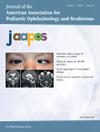Practices of a United States school-based vision program in referring children to community eye care
IF 1.2
4区 医学
Q3 OPHTHALMOLOGY
引用次数: 0
Abstract
Background
School-based vision programs (SBVPs) can increase children’s access to eye care services, yet some children have needs beyond the scope of SBVPs and require referral to community providers. We describe the referral practices of a large United States SBVP.
Methods
A retrospective, cross-sectional analysis was conducted using data from pre-Kindergarten through grade 12 students (5-22 years of age) who underwent an SBVP eye examination after a failed vision screening. Data on student demographics, refractive error, and school-level indicators of socioeconomic disadvantage were extracted. The proportion of students referred to community eye care was assessed. Mixed-effects logistic regression models were implemented to understand associations between referral status and student-or school-level characteristics.
Results
Of 97,107 students, 72,814 (75.0%) received eyeglasses and 13,884 (14.3%) were referred to community providers. Referrals were more common among younger students and those with greater school-level indicators of socioeconomic disadvantage. Compared with students with emmetropia, students with high hyperopia (OR = 7.21; 95% CI, 5.77-9.01) and high myopia (OR =3.70; 95% CI, 3.36-4.05) were more likely to be referred. Frequent referral reasons included refractive error (42.1%), amblyopia suspect (26.6%), and uncorrectable vision (26.1%). Nonreferred students were more likely to receive eyeglasses prescriptions (85.9% vs 9.4%).
Conclusions
SBVPs can address most uncorrected refractive error within the school setting, but a substantial proportion of students need further evaluation. Young students and those with high refractive error are more likely to require referral. SBVPs may benefit from developing resources and community networks to support students’ referral completion.
美国以学校为基础的视力项目将儿童转介到社区眼科护理的实践。
背景:基于学校的视力项目(SBVPs)可以增加儿童获得眼保健服务的机会,然而一些儿童的需求超出了SBVPs的范围,需要转介到社区提供者。我们描述了美国一个大型SBVP的转诊实践。方法:采用回顾性、横断面分析方法,对5-22岁的学前班至12年级学生(5-22岁)在视力筛查失败后接受SBVP眼科检查的数据进行分析。提取了学生人口统计、屈光不正和学校社会经济劣势指标的数据。评估转介到社区眼科护理的学生比例。采用混合效应逻辑回归模型来了解转诊状况与学生或学校层面特征之间的关联。结果:97107名学生中,72814名(75.0%)获得了眼镜,13884名(14.3%)转诊给社区提供者。转介在年龄较小的学生和学校社会经济劣势指标较高的学生中更为常见。与无远视的学生相比,高度远视的学生(OR = 7.21;95% CI, 5.77-9.01)和高度近视(OR =3.70;95% CI, 3.36-4.05)更有可能转诊。常见的转诊原因包括屈光不正(42.1%)、疑似弱视(26.6%)和视力不矫正(26.1%)。未转诊的学生更有可能得到眼镜处方(85.9% vs 9.4%)。结论:SBVPs可以解决学校环境中大多数未矫正的屈光不正,但很大一部分学生需要进一步评估。年轻学生和高度屈光不正的学生更有可能需要转诊。sbvp可以从开发资源和社区网络中受益,以支持学生完成转诊。
本文章由计算机程序翻译,如有差异,请以英文原文为准。
求助全文
约1分钟内获得全文
求助全文
来源期刊

Journal of Aapos
医学-小儿科
CiteScore
2.40
自引率
12.50%
发文量
159
审稿时长
55 days
期刊介绍:
Journal of AAPOS presents expert information on children''s eye diseases and on strabismus as it affects all age groups. Major articles by leading experts in the field cover clinical and investigative studies, treatments, case reports, surgical techniques, descriptions of instrumentation, current concept reviews, and new diagnostic techniques. The Journal is the official publication of the American Association for Pediatric Ophthalmology and Strabismus.
 求助内容:
求助内容: 应助结果提醒方式:
应助结果提醒方式:


